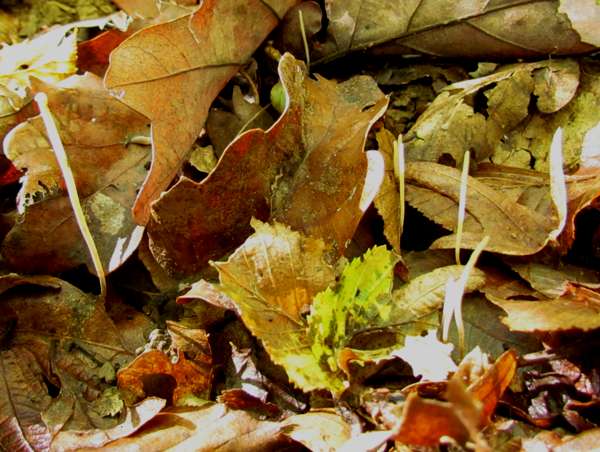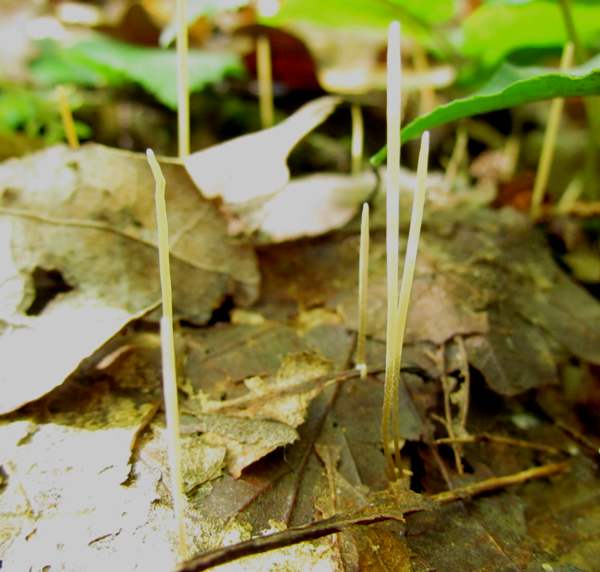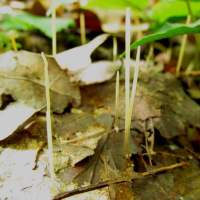Trees Birds Mammals Fish Amphibians Reptiles
Wild Algarve
Bookshop
Typhula juncea (Alb. & Schwein.) P. Karst. - Slender Club
Phylum: Basidiomycota - Class: Agaricomycetes - Order: Agaricales - Family: Typhulaceae
Distribution - Taxonomic History - Etymology - Identification - Culinary Notes - Reference Sources

Typhula juncea is one of those easily missed fungi, because the stems blend in so well with their background of decying leaves.

Distribution
Fairly common in deciduous woodlands throughout Britain and Ireland, this club fungus is also found in most countries in mainland Europe, and it is reported also from many parts of North America.
Taxonomic history
Some club-like and coral-like fungi are ascomycetous, but fungi of Typhula and related genera belong to the Basidiomycota.
Slender Club was first described scientifically in 1805 by German mycologist Johannes Baptista von Albertini (1769-1831) and German-Americal Lewis David de Schweinitz (1780-1834) who gave it the scientific name Clavaria triuncialis var. juncea. (Incidentally, de Schweinitz is generally considered to be the founding father of North American mycology.) The currently-accepted scientific name Typhula juncea dates from an 1882 publication by Finnish mycologist Petter Adolf Karsten.
Synonyms of Typhula juncea include Typhula ramentacea Fr., Clavaria juncea (Alb. & Schwein.) Fr., Clavaria hortulana Velen., Clavaria pilipes O.F. Müll., Clavariadelphus junceus (Alb. & Schwein.) Corner, Typhula oleae Maire, and Macrotyphula juncea (Alb. & Schwein.) Berthier.
Etymology
The generic name Typhula is Latin and means slightly smokey. Much more obvious, and again from Latin, is the specific epithet juncea, which means rush-like. (Rushes, Juncus species, have round cross sections.)
Identification guide
 |
Fruitbody
Yellowish to light ochre or orange brown clubs, slender and gently either straight, curved or wavy with initially pointed tips that become more rounded at maturity; clylindrical in cross-section; surface smooth. Usually unbranched, the stems are 3-10cm tall and 0.5-1.2mm diameter. |
| |
Spores
Ellisoidal-amygdaliform (almond shaped), smooth, 7-10.5 x 4-5.4µm; inamyloid, hyaline.
Spore print
White. |
Odour/taste |
Sour and unpleasant. |
Habitat & Ecological role |
Saprobic in damp woodlands, on the dead leaves or leaf stalks of deciduous broadleaf trees, especially Beech and Ash but also occasionally Sycamore. |
Season |
Autumn. |
Similar species |
Typhula pharcorrhiza has much larger spores and its fruitbodies arise from disc-like sclerotia on the surfaces of dead leaves. |
Culinary Notes
These tiny club fungi have no culinary value.
Reference Sources
Fascinated by Fungi, 2nd Edition, Pat O'Reilly 2016, reprinted by Coch-y-bonddu Books in 2022.
Typhula juncea (Alb. & Schwein.) P. Karst., Bidr. Känn. Finl. Nat. Folk 37: 181 (1882)
Dictionary of the Fungi; Paul M. Kirk, Paul F. Cannon, David W. Minter and J. A. Stalpers; CABI, 2008
Taxonomic history and synonym information on these pages is drawn from many sources but in particular from the British Mycological Society's GB Checklist of Fungi.
Top of page...
Fascinated by Fungi. Back by popular demand, Pat O'Reilly's best-selling 450-page hardback book is available now. The latest second edition was republished with a sparkling new cover design in September 2022 by Coch-y-Bonddu Books. Full details and copies are available from the publisher's online bookshop...